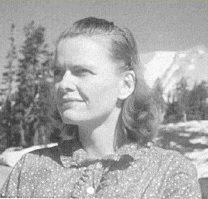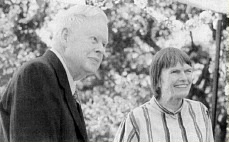born: Dec 8, 1919 in St. Louis, Missouri
died: July 30, 1985 in Oakland, California
“I think that I have always had a basic liking for the natural numbers. To me they are the one real thing. We can conceive of a chemistry that is different from ours, or a biology, but we cannot conceive of a different mathematics of numbers. What is proved about numbers will be a fact in any universe.”
First woman mathematician elected to the National Academy of Sciences. First woman president of the American Mathematical Society. MacArthur award. Contributed to the solution of Hilbert’s 10th Problem.
In 1900, at the Second International Congress of Mathematicians in Paris, David Hilbert (1862-1943), the most influential mathematician of his time, posed 23 open problems, whose solutions, he deemed, would be of the most profound significance to the advancement of mathematics. These problems have challenged many of the best mathematical minds of the twentieth century. Solving one of Hilbert’s problems is often enough to secure the solver’s mathematical reputation. Julia Robinson was one of three mathematicians whose combined work settled the 10th problem on Hilbert’s list: Find an effective way to determine whether a polynomial equation with integer coefficients and one or more unknowns has any integer solutions. (Sort of like the quadratic formula.)
Julia (Bowman) Robinson grew up in Arizona and southern California. She was slow to talk and, as a child, pronounced words so oddly that no one except her sister, Constance, could understand her and for a time got in the habit of speaking for her (as she did 60 years later when she wrote Julia’s biography). Julia’s mother, a kindergarten and first grade teacher, said that Julia was the stubbornest child she ever knew. “I would say that my stubbornness has been to a great extent responsible for whatever success I have had in mathematics.” When she was 9 years old, Julia came down with scarlet fever, followed by a bout with rheumatic fever, and she was forced to spend a year in bed at the home of a practical nurse.
When Julia was finally well enough to return to school, she was two years behind. But, working with a tutor three mornings a week, she completed the state syllabi for the fifth, sixth, seventh and eighth grades in one year. In junior high school she was given an IQ. test and, being a slow reader and unaccustomed to taking tests, did poorly; her IQ. was recorded as 98, two points below normal. It was during that time Julia first became interested in mathematics when she learned that no matter how far the decimal expansion of the square-root of two was carried out it would never become periodic. “I didn’t see how anyone could know that — [I thought] all they could know is that the expansion had not become periodic in the part that was calculated. I tried to check it with my newly acquired skills at extracting square roots but finally gave up. After all, I couldn’t go on forever either!”
By Julia’s junior year, she was the only girl at San Diego High School still taking mathematics and physics. “I was very shy, but entering a roomful of boys did not disconcert me. I have never given much thought to what other people think about me. Naturally I was interested in some of the boys, but they didn’t pay attention to me except when they had a question about the homework. None of them ever seemed bothered by the fact that a girl was getting the best grades.” At graduation she received awards for mathematics and for all-around excellence in science. Her parents expressed some concern about what the future could possibly hold for “such a girl,” but consoled themselves with the hope that she “would marry a professor.”
Julia and her sister both enrolled at San Diego State College. Julia majored in mathematics, expecting to become a school teacher. Even through her senior year she “had no idea that such a thing as a ‘mathematician’ (as opposed to a math teacher) existed.” Her first glimpse of what mathematics really was came from reading E.T. Bell’s classic, Men of Mathematics. “I was especially excited by some of the theorems of number theory, and I used to recount these to Constance at night. She soon found that if she wasn’t ready to go to sleep, she could keep me awake by asking questions about mathematics.” With her sister’s financial assistance, Julia transferred to the University of California at Berkeley, “where there was a real department of mathematics,” and completed her BA. When she tried to get a job teaching, she was blocked by pressure to recruit more men to the public school teaching ranks. She applied for jobs with various companies in San Francisco, but they weren’t interested in her mathematical training. “They asked if I could type. A few years later, after we were in the war, they suddenly did become interested.” Finally, she landed a teaching assistantship in the Statistics Department at Berkeley, and she continued her studies. “I was blissfully happy at Berkeley. In San Diego there had been no one at all like me. Everyone has his or her fairy story, mine is the story of the ugly duckling. At Berkeley, I found that I was really a swan. There were lots of people just as excited as I was about mathematics, and there was quite a bit of departmental social activity in which I was included.”
Julia was inspired by a brilliant, young professor, Raphael Robinson, who became her friend, her mentor, and in December, 1941, her husband. There was a rule at Berkeley that members of the same family could not teach in the same department, so during World War II, Julia continued to work in the statistics lab and audited math classes, but [at that time] “I was more interested in shopping for furniture and starting a family.” After suffering a miscarriage Julia learned that she had a heart problem that stemmed from her childhood illnesses, and plans of a family had to be abandoned. She fought the ensuing depression by immersing herself in the solution of a new problem and in 1947 resumed work on her Ph.d. In 1948 she finished her doctorate and began to work on Hilbert’s 10th Problem, which would occupy the largest portion of her career. “In the beginning I was just thinking about a smaller specific problem that was not of particular interest in itself; however, it appealed to me. If I had known it was linked to the 10th Problem, I probably would never have tackled it.”
During the 1950’s Julia spent a lot of time on politics. She actively supported Adlai Stevenson’s presidential campaigns, worked at the grass roots level in California state elections, and opposed Berkeley’s “loyalty oath” of the McCarthy era. She published a few papers and occasionally accepted short-term mathematical jobs in industry. And she continued to struggle with Hilbert’s 10th Problem. By 1961, although she underwent major surgery to repair her heart that had been weakened by childhood illnesses, Julia had taken a giant step toward an answer and published her results in a joint paper. Still the ultimate solution eluded her for another nine years. “[At family celebrations] when it came time for me to blow out the candles on my birthday cake, I always wished, year after year, that [Hilbert’s] 10th Problem would be solved — not that I would solve it, but just that it would be solved. I felt that I couldn’t bear to die without knowing the answer.”
Finally, in 1970 Yuri Matijasevich, a 22 year-old Russian mathematician, used Julia’s 1961 results to settle the 10th Problem once and for all — there can be no general method for determining whether a given Diophantine equation has an integer solution. She immediately wrote to Matijasevich, ” …. now I know it is true, it is beautiful, it is wonderful. If you really are 22, I am especially pleased to think that when I first started [working on] the problem, you were a baby and I just had to wait for you to grow up!”
Throughout the 1960’s and half of the 70’s, Julia held the rank of [part-time] ‘lecturer in mathematics’ at Berkeley, the lowest rung on the academic ladder. In 1976 the press called the department to find out just who Julia Robinson was. “That’s Professor Robinson’s wife. Why?” the chairman answered. “Well,” replied the caller, “Professor Robinson’s wife has just been elected to the National Academy of Sciences [the first woman mathematician to be so honored].” She was promptly offered a full professorship with the duty of teaching one-fourth time [because of her health], which she accepted. Over the next 10 years Julia received numerous awards, including honorary doctorates, a MacArthur Foundation Prize, election to the American Academy of Arts and Sciences, and the presidency of the American Mathematical Society [again the first woman to hold this office].
In August, 1984, a day after presiding over her last AMS meeting, she learned she had leukemia and died less than a year later. Julia’s estate and that of her husband were willed to U. C. Berkeley in the form of a fund to provide fellowships for graduate students in mathematics.
“All this attention has been gratifying but also embarrassing. What I really am is a mathematician. Rather than being remembered as the first woman this or that, I would prefer to be remembered, as a mathematician should, simply for the theorems I have proved and the problems I have solved.”
(Click JR for more quotes and observations about Julia Robinson.)
Condensed by Larry Curnutt from Julia: A Life in Mathematics by Constance Reid, Mathematical Association of America, 1996.
Last Updated September 22, 2022



